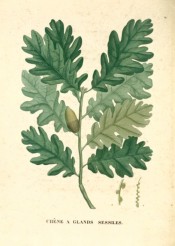Quercus robur L. var. sessiliflora
Very similar to Quercus robur L. which see. It differs mainly in having distinctly stalked leaves and stalkless acorns. To 35m. [RHSD, Hortus, Hilliers’].
Horticultural & Botanical History
‘In comparing the wood of the two species of British, oak, that of Q. pedunculata is found the most easy to split, and the stiffest and easiest to break, and yet the most difficult to bend, while that of Q. sessiliflora has the advantage in toughness and weight. Notwithstanding this comparison, the wood of both kinds is used indiscriminately for all purposes, and the remarks made on the former species are equally applicable to the present one. The beauty of oak foliage is universally allowed, but that of Q. sessiliflora may be said to be most admired in single leaves, and that of the other species in tufts of leaves. This species is known by the name of Durmast, and the characteristics of its wood are said to depend on the smaller proportion of silver grain or flower (terms used by carpenters and others to signify the medullary rays of botanists) possessed by the wood of the durmast in comparison with that of the other kind. On this account the wood of the durmast has frequently been confounded, with that of the sweet chestnut, and for this reason it is less valuable for the purposes of the cabinet-maker than the wood of Q. pedunadata, in which the silver grain is much more conspicuous. The timber of the durmast has been stated, on insufficient grounds, to be less durable than that of the common oak. The wood of these trees, when stained green by the growth of a peculiar fungus, Peziza aeruginosa, is highly prized by cabinet-makers and workers in Tunbridge ware. […] In the midland counties of England there is always much speculation as to whether the leaves of the oak or of the ash will appear first, as the following proverb is implicitly relied on: —
“If the oak’s before the ash.
Then you’ll only get a splash;
If the ash precedes the oak.
Then you may expect a soak.”
Considering the different habits of the two trees, there may be reason in the rhyme. The oak sends its roots deep into the soil, and its leafing is advanced or retarded by a warm or cold spring. The roots of the ash are nearer the surface, and so a wet spring hastens its growth, while a dry one would retard it. Rain, moreover, does not affect the oak so much as it does the ash. A curious phenomenon is sometimes presented by the oak, which is mentioned by Mr. White in his “Natural History of Selbourne.” We hear, in country districts, of “raining trees,” especially of “raining oaks,” and Mr. White accounts for the fact in this way: “In heavy fogs, in elevated situations especially, trees are perfect alembics, and no one who has not attended to such matters can imagine how much water one tree will distil in a night’s time by condensing the vapour, which trickles down the twigs and boughs, so as to make the ground below quite in a float. In Newton Lane, in October 1775, on a misty day, a particular oak in leaf dropped so fast that the cartway stood in puddles, and the ruts ran with water, though the ground in general was dusty.” [English Botany p.157/1863-86].
This tree was also figured by Saint-Hilaire in Traite des Arbres Forestiers. [Saint-Hilaire Arb. pl.14/1824’.
History at Camden Park
Listed in the 1843 and 1845 catalogues as ‘Quercus robur - Sessile fruited’. This is almost certainly the same plant as ‘Quercus sessiliflora’ listed in the 1850 and 1857 catalogues [T.810/1850] although the latter was obtained from Loddiges’ Nursery, included among desiderata in a letter dated 16th April 1846. Macarthur wrote on 14th February 1848: ‘I have to thank for your two batches of plants. The first by the ‘Magora’, packed in moss, arrived generally in very bad condition. I succeeded in saving from amongst them only the Quercus sessiliflora and part of the paeonies.’ [MP A2933-1, p.147].
Notes
Published Feb 03, 2010 - 05:03 PM | Last updated Feb 03, 2010 - 05:09 PM
| Family | Fagaceae |
|---|---|
| Category | |
| Region of origin | Europe to Asia |
| Synonyms |
|
| Common Name | Durmast oak, Sessile oak |
| Name in the Camden Park Record |
Quercus robur - Sessile fruited Quercus sessiliflora |
| Confidence level | high |


